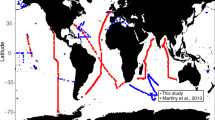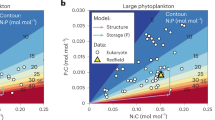Abstract
Nearly 75 years ago, Alfred C. Redfield observed a similarity between the elemental composition of marine plankton in the surface ocean and dissolved nutrients in the ocean interior1. This stoichiometry, referred to as the Redfield ratio, continues to be a central tenet in ocean biogeochemistry, and is used to infer a variety of ecosystem processes, such as phytoplankton productivity and rates of nitrogen fixation and loss2,3,4. Model, field and laboratory studies have shown that different mechanisms can explain both constant and variable ratios of carbon to nitrogen and phosphorus among ocean plankton communities. The range of C/N/P ratios in the ocean, and their predictability, are the subject of much active research5,6,7,8,9,10,11,12. Here we assess global patterns in the elemental composition of phytoplankton and particulate organic matter in the upper ocean, using published and unpublished observations of particulate phosphorus, nitrogen and carbon from a broad latitudinal range, supplemented with elemental data for surface plankton populations. We show that the elemental ratios of marine organic matter exhibit large spatial variations, with a global average that differs substantially from the canonical Redfield ratio. However, elemental ratios exhibit a clear latitudinal trend. Specifically, we observed a ratio of 195:28:1 in the warm nutrient-depleted low-latitude gyres, 137:18:1 in warm, nutrient-rich upwelling zones, and 78:13:1 in cold, nutrient-rich high-latitude regions. We suggest that the coupling between oceanic carbon, nitrogen and phosphorus cycles may vary systematically by ecosystem.
This is a preview of subscription content, access via your institution
Access options
Subscribe to this journal
Receive 12 print issues and online access
$259.00 per year
only $21.58 per issue
Buy this article
- Purchase on Springer Link
- Instant access to full article PDF
Prices may be subject to local taxes which are calculated during checkout



Similar content being viewed by others
References
Redfield, A. James Johnstone Memorial Volume 176–192 (Liverpool Univ. Press, 1934).
Tyrrell, T. The relative influence of nitrogen and phosphorus on oceanic primary production. Nature 400, 525–527 (1999).
Mills, M. & Arrigo, K. Magnitude of oceanic nitrogen fixation influenced by the nutrient uptake ratio of phytoplankton. Nature Geosci. 3, 412–416 (2010).
Lenton, T. & Klausmeier, C. A. Biotic stoichiometric controls on the deep ocean N:P ratio. Biogeosciences 4, 353–367 (2007).
Geider, R. J. & LaRoche, J. Redfield revisited: Variability of C:N:P in marine microalgae and its biochemical basis. Eur. J. Phycol. 37, 1–17 (2002).
Bertilsson, S., Berglund, O., Karl, D. M. & Chisholm, S. W. Elemental composition of marine Prochlorococcus and Synechococcus : Implications for the ecological stoichiometry of the sea. Limnol. Oceanogr. 48, 1721–1731 (2003).
Ho, T. et al. The elemental composition of some marine phytoplankton. J. Phycol. 39, 1145–1159 (2003).
Karl, D., Bidigare, R. & Letelier, R. Long-term changes in plankton community structure and productivity in the North Pacific Subtropical Gyre: The domain shift hypothesis. Deep-Sea Res. II 48, 1449–1470 (2001).
Arrigo, K. et al. Phytoplankton community structure and the drawdown of nutrients and CO2 in the Southern Ocean. Science 283, 35–367 (1999).
Lomas, M. W. et al. Sargasso Sea phosphorus biogeochemistry: An important role for dissolved organic phosphorus (DOP). Biogeosciences 7, 695–710 (2010).
Weber, T. & Deutsch, C. Ocean nutrient ratios governed by plankton biogeography. Nature 467, 550–554 (2010).
Weber, T. & Deutsch, C. Oceanic nitrogen reservoir regulated by plankton diversity and ocean circulation. Nature 419, 419–424 (2012).
Loladze, I. & Elser, J. The origins of the Redfield nitrogen-to-phosphorus ratio are in a homoeostatic protein-to-rRNA ratio. Ecol. Lett. 14, 244–250 (2011).
Deutsch, C. & Weber, T. in Annual Review of Marine Science Vol. 4 (eds Carlson, C. A. & Giovannoni, S. J.) http://dx.doi.org/10.1146/annurev-marine-120709-142821 (Annual Reviews, 2012).
Price, N. Elemental stoichiometry and composition of an iron-limited diatom. Limnol. Oceanogr. 50, 1159–1171 (2005).
Twining, B., Baines, S. & Fisher, N. S. Elemental stoichiometries of individual plankton collected during the Southern Ocean Iron Experiment (SOFeX). Limnol. Oceanogr. 49, 2115–2128 (2004).
Rhee, G. Effect of N:P atomic ratios and nitrate limitation on algal growth, cell composition, and nitrate uptake. Limnol. Oceanogr. 23, 10–25 (1978).
Elser, J. et al. Growth rate-stoichiometry couplings in divers biota. Ecol. Lett. 6, 936–943 (2003).
Klausmeier, C. A., Litchman, E., Daufresne, T. & Levin, S. A. Optimal nitrogen-to-phosphorus stoichiometry of phytoplankton. Nature 429, 171–174 (2004).
Jackson, G. & Williams, P. Importance of dissolved organic nitrogen and phosphorus to biological nutrient cycling. Deep-Sea Res. I 32, 223–235 (1985).
Verity, P., Williams, S. & Hong, Y. Formation, degradation and mass:volume ratios of detritus derived from decaying phytoplankton. Mar. Ecol. Prog. Ser. 207, 53–68 (2000).
Morris, R. M. et al. SAR11 clade dominates ocean surface bacterioplankton communities. Nature 420, 806–810 (2002).
Bidigare, R. et al. Subtropical ocean ecosystem structure changes forced by North Pacific climate variations. J. Plankton Res. 31, 1131–1139 (2009).
Wright, S. W. & Jeffrey, S. W. Fucoxanthin pigment markers of marine phytoplankton analysed by HPLC and HPTLC. Mar. Ecol. Prog. Ser. 38, 259–266 (1987).
Sterner, R. et al. Scale-dependent carbon:nitrogen:phosphorus seston stoichiometry in marine and freshwaters. Limnol. Oceanogr. 53, 1169–1180 (2008).
Heldal, M., Scanlan, D., Norland, S., Thingstad, T. & Mann, N. Elemental composition of single cells of various strains of marine Prochlorococcus and Synechococcus using X-ray microanalysis. Limnol. Oceanogr. 48, 1732–1743 (2003).
Locarnini, R. et al. World Ocean 2009, Vol. 1, Temperature, 184pp (ed NOAA Atlas NESDIS 68, US Government Printing Office, 2010).
Figueiredo, M. & Jain, A. Unsupervised learning of finite mixture models. Pattern Anal. Mach. Intel. 24, 381–393 (2002).
Steinberg, D. K. et al. Overview of the US JGOFS Bermuda Atlantic Time-series Study (BATS): A decade-scale look at ocean biology and biogeochemistry. Deep-Sea Res. II 48, 1405–1447 (2001).
Casey, J., Lomas, M. W., Mandecki, J. & Walker, D. Prochlorococcus contributes to new production in the Sargasso Sea deep chlorophyll maximum. Geophys. Res. Lett. 34, L10604 (2007).
Acknowledgements
We thank S. Allison, C. Klausmeier, E. Litchman and J. Martiny for their comments. The National Science Foundation Dimensions of Biodiversity (A.C.M., M.W.L. and S.A.L.), Biological Oceanography programs (A.C.M. and M.W.L.), Department of Energy Biological and Environmental Research Climate and Environmental Sciences Division (J.K.M. and F.W.P.), and UCI Environment Institute (A.C.M. and J.A.V.) provided financial support for this work.
Author information
Authors and Affiliations
Contributions
All authors participated in the analysis and interpretation of results. M.W.L. collected the newly presented cruise data and taxon-specific plankton elemental data. A.C.M. and M.W.L. designed the study and wrote the paper.
Corresponding author
Ethics declarations
Competing interests
The authors declare no competing financial interests.
Supplementary information
Supplementary Information
Supplementary Information (PDF 1049 kb)
Rights and permissions
About this article
Cite this article
Martiny, A., Pham, C., Primeau, F. et al. Strong latitudinal patterns in the elemental ratios of marine plankton and organic matter. Nature Geosci 6, 279–283 (2013). https://doi.org/10.1038/ngeo1757
Received:
Accepted:
Published:
Issue Date:
DOI: https://doi.org/10.1038/ngeo1757
This article is cited by
-
Atmospheric deposition and river runoff stimulate the utilization of dissolved organic phosphorus in coastal seas
Nature Communications (2024)
-
Vertical distribution of picocyanobacteria in deep lakes: the influence of inorganic turbidity
Aquatic Sciences (2024)
-
Grazing by nano- and microzooplankton on heterotrophic picoplankton dominates the biological carbon cycling around the Western Antarctic Peninsula
Polar Biology (2024)
-
Changes in nutrient stoichiometry in responding to diatom growth in cyclonic eddies
Geoscience Letters (2023)
-
Virus–pathogen interactions improve water quality along the Middle Route of the South-to-North Water Diversion Canal
The ISME Journal (2023)



